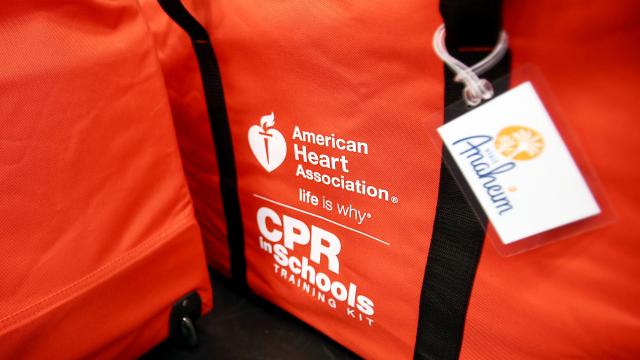Recently, as I stood in the checkout line at my local grocery store, the unusual sight of an employee running caught my eye. I realised almost immediately that he was rushing to collect the Automated External Defibrillation (AED) device fixed to the wall in front of my lane. I am a Registered Nurse and I knew that the need for the AED meant someone was seriously ill in the store. Sure enough, I looked to my right and an elderly man was unconscious on the ground.
I ran over to the scene and was relieved to see that several bystanders had started CPR, and that emergency services were already route. As I took over chest compressions from another customer, I identified myself as a nurse. The customer looked at me and said, “Oh, thank goodness, I didn’t know what to do when he passed out.”
Together, we shared chest compressions until the paramedics arrived to secure the scene. We also attached the AED device to the man’s chest.
An AED is an easy to use device that can analyse heart rhythms and determine whether heart muscle should be shocked back into an electrical pattern. Many people are familiar with the more traditional version used in hospitals. An AED is designed for the average, non medical person to be able to assist a patient in cardiac arrest. With simple, clear instructions and voice prompting, a Good Samaritan can attach the device to a patient and follow the instructions given.
After the ambulance left and I had time to process the situation, I realised that my medical training gives me confidence in emergency situations and that a sudden emergency or accident can be terrifying for a person unfamiliar with medical equipment.
Fortunately, there are things people without formal medical training can do in an emergency that will not only save precious seconds but could also save a life:
Don’t be afraid to assist if you see someone having a medical emergency
All states have Good Samaritan laws that protect those who try to render reasonable medical assistance in a medical emergency. In the case of the man in my grocery store, one of the responders said, “I was so afraid that I was going to do something wrong.” I assured her that the very best thing she did was to stop and try to offer help. Though the outcome wasn’t what we’d hoped, everything we did that day was aimed at trying to save a man’s life, and you will never be in trouble with authorities for trying to help someone in distress or danger.
If you are having trouble finding the right rhythm for chest compressions, start singing. Yes, really.
When we are panicked or in an emergency situation, it’s natural to want to do everything faster. But, in the case of chest compressions, chaotic pressing on the chest isn’t the best option. If you find yourself having to render chest compressions on an accident victim, take a deep breath and channel your inner John Travolta: start singing or humming the tune of “Staying Alive” and pump with the beat of the song. (“Baby Shark” will also do the trick here.)
Doing so will help you focus until help arrives and you can elicit those around you to sing with you so that you can stay on beat.
Familiarise yourself with the location of the AED device in the buildings you frequent
We all have two or three buildings where we spend a lot of our time. Whether it’s your office building, your kid’s school, or your local gym, most public spaces have an AED device. Taking the time to locate the device will save precious time in a real emergency. (Similarly, it’s a good idea to always keep tabs on the location of the fire extinguisher in places you visit frequently.)
And, take a moment to think about the route you’d have to take from your desk or your child’s classroom, too, so you are prepared if necessary. Every second counts.
While waiting for the paramedics, note the time the incident started and try to obtain basic identifying information about the victim from family
The man in my grocery store was accompanied by his wife and she was visibly distraught at the sight of her husband on the floor. A store employee helped her take deep breaths and we asked her to tell us about him: his name, his medical conditions, his profession.
As she talked, we wrote down information that we could then give to the paramedics when they arrived. Having that information available when the paramedics arrive will assist in making sure the patient is able to leave the scene as soon as possible.
Take a local CPR class with a friend, because you never know when an emergency will strike
CPR classes and techniques have changed a lot since we all learned to yell, “Annie, Annie are you ok?” and rescue breathe on manikin. Find a group of friends and sign up for a class at your local first aid class and encourage those around you to brush up on basic first aid. The best gift you can give those around you is the familiarity with live saving measures.

Comments
One response to “Prepare To Be The Person Who Helps In A Medical Emergency”
Enrol in a first aid course at least once a year.
Youll get a certification and you’ll learn all the basic stuff you need to know.
You might never need it, But you’ll be thankful in the situation you do.